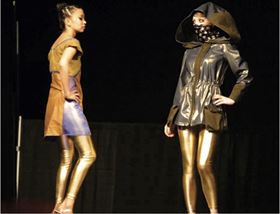A fashion designer often considers textiles as works of art, meant for purely aesthetic value. A fiber scientist, on the other hand, sees textiles as workable media, with large available surface area and the potential to be more than just pleasing to the eye. Manipulation of nanoscale phenomena to create synergies between natural fibers and nanomoieties could offer a solution for this apparent dichotomy by creating functionality while preserving appearance and comfort.
Cotton continues to be the most commonly used and popular clothing material. It is not only renewable but also biodegradable and readily available. Since cotton is composed mainly of cellulose molecules, adding functionality to cotton fibers is a challenging endeavor as physical and chemical heterogeneities need to be overcome. For example, the cross section of a cotton fiber is nonplanar and has convex and concave surfaces with high curvature that prevent the use of traditional surface chemistry techniques. Furthermore, cotton fibers are twisted along their axes, which adds complexity to existing surface treatments. Cotton fibers are also chemically heterogeneous since different crops exhibit different properties depending on the conditions of the soil, weather, and processing. Therefore, wet chemistry methods rather than physical ones appear to be more robust and able to modify the surface of natural fibers. Using compounds carrying an end reactive functional group capable of covalent binding to the hydroxyls on cellulose and another end group carrying a positive charge can create permanent cationic charges on cotton substrates. The availability of positively charged substrates allows the use of self-assembly techniques, driven by electrostatic interactions, to modify the surface of cotton.
Metal nanoparticles can be produced using diverse routes such as reverse-micelle synthesis, colloidal assemblies, laser-beam processing, mechanical grinding, and many other methods. As the particle size decreases, aggregation becomes an issue. Coating particles with polymers, surfactants, or other polyelectrolytes can reduce aggregation by manipulating steric effects as well as electrostatic interactions. If the coatings contain an anionic charge, the particles can be directed to assemble on the surface of cationic cotton by judiciously controlling the electrostatic interactions between the substrate and the particles. Hence, using electrostatically driven assembly techniques can provide conformal coatings over the surface of the natural fibers.
By assembling metal nanoparticles over the surface of natural fibers such as cotton, several applications for this truly flexible and portable nanobiocomposite material can be envisioned. For example, when Ag nanoparticles are deposited, antibacterial properties are imparted onto cotton. Au nanoparticles allow the use of molecular ligands so that viruses could be trapped or the presence of biological compounds rapidly detected. Pt and Pd nanoparticles impart catalytic properties such as the decomposition of harmful gases or toxic industrial chemicals. More importantly, these functions are incorporated into the cotton fabrics without affecting their texture or comfort. The cross-sectional dimension of cotton fibers is in the micron range so the presence of a monolayer of nanoparticles will not be perceptible to the touch. While impressive, incorporating these functionalities into clothing may not be of great interest to fashion designers who usually give priority to appearance over function.
However, an additional benefit of creating conformal monolayers of nanoparticles on top of cotton or textile fibers is the presence of surface plasmons. These plasmons are strong optical extinctions that can be used to control color by manipulating the interaction of light with the coated material. This well-known phenomenon is possible by tailoring the surface shape and size of the nanoparticles, thereby controlling the type of surface plasmons that can couple to and propagate across the modified textile. In other words, the assembly of nanoparticles over textile fibers offers the designer an in situ tunable palette of colors to choose from. Having a controllable color palette for any fabric is a dream-made-reality for a fashion designer. For example, if the designer desires to have a golden finish for his/her piece, Ag nanoparticles can be used to create a shiny metallic-yellow color while simultaneously imparting antibacterial properties.
The ability to control color in fabrics in a tunable fashion, without the use of dyes, while adding functionality is a makeover for the old faithful, cotton; it is a match between fiber science and apparel design made possible by nanotechnology.
 A dress and jacket contain Ag and Pd nanoparticles with antibacterial and air-purifying qualities, designed by Cornell Fashion Design student Olivia Ong. (Photo by Peter Moran.)
A dress and jacket contain Ag and Pd nanoparticles with antibacterial and air-purifying qualities, designed by Cornell Fashion Design student Olivia Ong. (Photo by Peter Moran.)